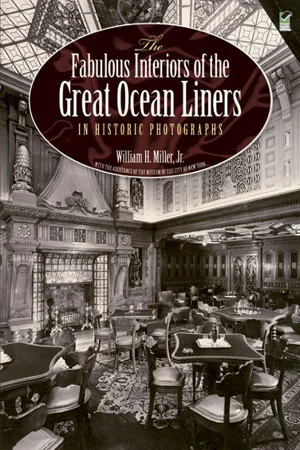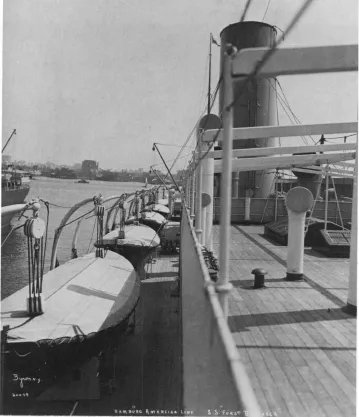
eBook - ePub
The Fabulous Interiors of the Great Ocean Liners in Historic Photographs
This is a test
- 160 pages
- English
- ePUB (mobile friendly)
- Available on iOS & Android
eBook - ePub
The Fabulous Interiors of the Great Ocean Liners in Historic Photographs
Book details
Book preview
Table of contents
Citations
About This Book
Some 200 superb photographs — in long shots and close-ups — capture exquisite interiors of world's great "floating palaces" — 1890s to 1980s: Titanic, Île de France, Queen Elizabeth, United States, Europa, more. Informative captions provide key details.
Frequently asked questions
At the moment all of our mobile-responsive ePub books are available to download via the app. Most of our PDFs are also available to download and we're working on making the final remaining ones downloadable now. Learn more here.
Both plans give you full access to the library and all of Perlego’s features. The only differences are the price and subscription period: With the annual plan you’ll save around 30% compared to 12 months on the monthly plan.
We are an online textbook subscription service, where you can get access to an entire online library for less than the price of a single book per month. With over 1 million books across 1000+ topics, we’ve got you covered! Learn more here.
Look out for the read-aloud symbol on your next book to see if you can listen to it. The read-aloud tool reads text aloud for you, highlighting the text as it is being read. You can pause it, speed it up and slow it down. Learn more here.
Yes, you can access The Fabulous Interiors of the Great Ocean Liners in Historic Photographs by William H., Jr. Miller in PDF and/or ePUB format, as well as other popular books in Technology & Engineering & Marine Transportation. We have over one million books available in our catalogue for you to explore.
Information

NOTE
The statistics given for some of the liners may not necessarily agree with those given in other works. Many liners underwent considerable and frequent changes during their careers, which often altered their tonnages, speeds and passenger capacities and configurations. Except where noted otherwise, the statistics quoted here are those applicable on the date of commission.

New York, April 8, 1939. More than other modes of transportation, the luxury liners possessed great style and made a deep impression upon their times and upon history. Several great names mentioned on these pages are included in this dramatic aerial view. At the top is the Conte di Savoia of the Italian Line, followed by the Georgic and Queen Mary of Cunard-White Star, the Paris and De Grasse of the French Line, the Europa (about to dock) of the North German Lloyd, and finally, the New York of the Hamburg-America Line.



FÜRST BISMARCK, 1890.
The British dominated the transatlantic passenger trade to North America with the Cunard and White Star lines; their chief rivals were the Germans, who were represented by the Hamburg-America Line of Hamburg and the North German Lloyd of Bremen. Their business followed a similar pattern: upper-deck quarters for first class, less opulent and less spacious accommodations for second class, cramped and crowded areas for the most lucrative passengers—the immigrants in steerage. Basically, the steerage was used only on westbound sailings. On eastbound trips it was frequently used for the stowage of small cargo.
The Fürst Bismarck was among the moderately sized German passenger ships that worked the trade between Hamburg and New York. Her sailings were balanced between passengers and freight. In later years, she was also used for periodic cruises—then quite a novelty but possessed of great promise, according to her owners, the Hamburg-America Line. The Fürst Bismarck was sold to the Russians in 1904 and then to the Austro-Hungarian Navy in 1912 before being scrapped in 1924.
By the 1890s, public rooms aboard passenger steamers had come into their own. In earlier days, in the time of the Atlantic paddle steamers, passengers often shared one common salon, which was usually convertible to the dining area. The first-class dining room of the Fürst Bismarck (opposite, top) featured swivel chairs that were bolted to the floor. Such seating persisted until the First World War. Unlike some of the larger liners, such as the Cunarders and larger German vessels, the room was a single deck in height. Other, more elaborate creations rose two and sometimes three decks high, often with a great glass skylight overhead. The room was lighted by early Edison bulbs, distinguished by the small nipple at the bottom.
The first-class music room (opposite, bottom) served several purposes: for piano and other musical recitals, for reading, for writing and for socializing. The banquette at the far end of the room was used by the female passengers only. Such a unit was a common feature of the period in Germany. The white chairs, quite similar to Windsor chairs, forming a dramatic pattern, gave an organized, upright style to the room. The piano was covered with a silk drape, common in the decor of the time. Overhead was a beamed wooden ceiling.
Some of the ship’s finest first-class cabins (above) used a Renaissance style. The heavy curtains eliminated unwanted light but, more important, provided additional warmth. Heating systems aboard such ships were modest at best, often nonexistent in the lower classes. The wooden bed rail offered sleeping passengers some security in a pitching and rolling ship. After the turn of the century, this style was replaced by parallel-bed or bunk arrangements. [Built by Vulkan Shipyards, Stettin, Germany, 1890. 8,874 gross tons; 520 feet long; 57 feet wide. Steam triple expansion engines geared to twin screw. Service speed 19 knots. 1,292 passengers (420 first class, 172 second class, 700 third class).]

The Fürst Bismarck (above). The upper outdoor decks of passenger steamers were considered part of their accommodation. The Germans, more than others, heavily publicized the therapeutic qualities of a sea voyage. Therefore, open-air deck spaces were provided first- and second-class passengers for strolling, games (such as shuffleboard) and lounging on long benches. However, these decks were not overly spacious. Early steamers such as the Fürst Bismarck had top decks that were cluttered with lockers, deckhouses, ventilators, piping, tubes, lifeboats, davits and the casings surrounding the funnels. Furthermore, transatlantic travel was not always conducive to outdoor activities. The eight-to-12-day passages were often cold, sometimes wet and foggy, and occasionally disrupted by huge storms.
The upper-deck sections of passenger ships did not change considerably until the thirties, with the advent of such liners as the Champlain and Normandie, both of which offered totally clutter-free open-air decks. Consequently, this view, made about 1900, could easily be mistaken for a view of 1930 or 1940. The photograph also shows the early Manhattan skyline, seen across the Hudson from Hoboken, where the German liners berthed until the First World War.
AMERIKA, 1905 (opposite).
Like the British, the Germans persisted in developing successively larger, more luxurious and often faster passenger liners. Competition was prompted by a maritime race between the two nations and early marketing attempts to lure more passengers, both in first class and in the highly profitable steerage. While some attention was paid to improving standards in third class and steerage, the greatest efforts for novelty were applied to first class. These quarters were patronized by such types as American tycoons, minor European royals and the privileged set that made the annual grand tour.
When it was commissioned in October 1905, the Hamburg-America Line’s Amerika was the largest liner afloat, a distinction it held for just a year. Although the Germans had reached a notable technological level, building in their own shipyards some of the world’s largest and fastest ships, Hamburg-America turned to the master shipbuilders of the day, the Harland & Wolff Company in Belfast, for this, their new flagship. However, while the ship was in fact foreign-built, it was Germanic in tone. The first-class restaurant (opposite, top) is truly German—a room where nothing is left unadorned. Fine wrought-iron rails lined the second-deck level, an area that here was used for staterooms but that, on later ships, was converted to an upper-level restaurant. Two elaborately carved caryatids rest against brackets. The chairs continue to be of the swivel type bolted to the floor and long rows of tables persist. Among the larger liners, individual tables—with seating for four, six or eight—first appeared on the White Star liners Olympic and Titanic in 1911–12.
The Amerika was notable also in offering the first liner elevator for passengers and, even more notably, for its private first-class grill room. Such an amenity, operated by the famed Ritz-Carlton Company, offered the more demanding and reclusive travelers both intimacy and privacy as well as unparalleled shipboard dining, with offerings ranging from grilled antelope to roast ox and even seafood selections taken fresh from a tank. The entrance fee to the grill room was comparable to the full fare in steerage.
In addition to providing comfortable cabins, fine lounges and novelties, the directors of the Hamburg-American line were also concerned with the rigors of the Atlantic crossing itself. Some passengers, particularly the ladies, often needed to forget that they were in fact aboa...
Table of contents
- Cover Page
- Title Page
- Dedication
- Sources of the Photographs
- Copyright Page
- Acknowledgments
- Foreword
- Introduction
- Bibliography
- Alphabetical List of Ships Illustrated
- Note
- Back Cover